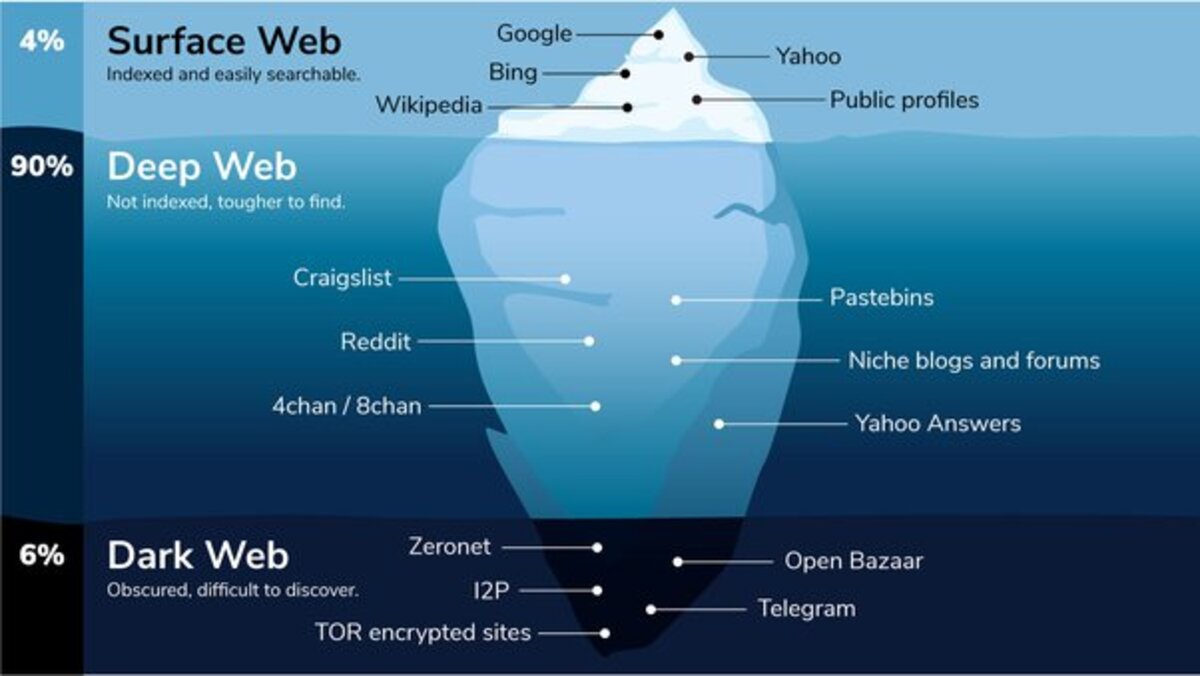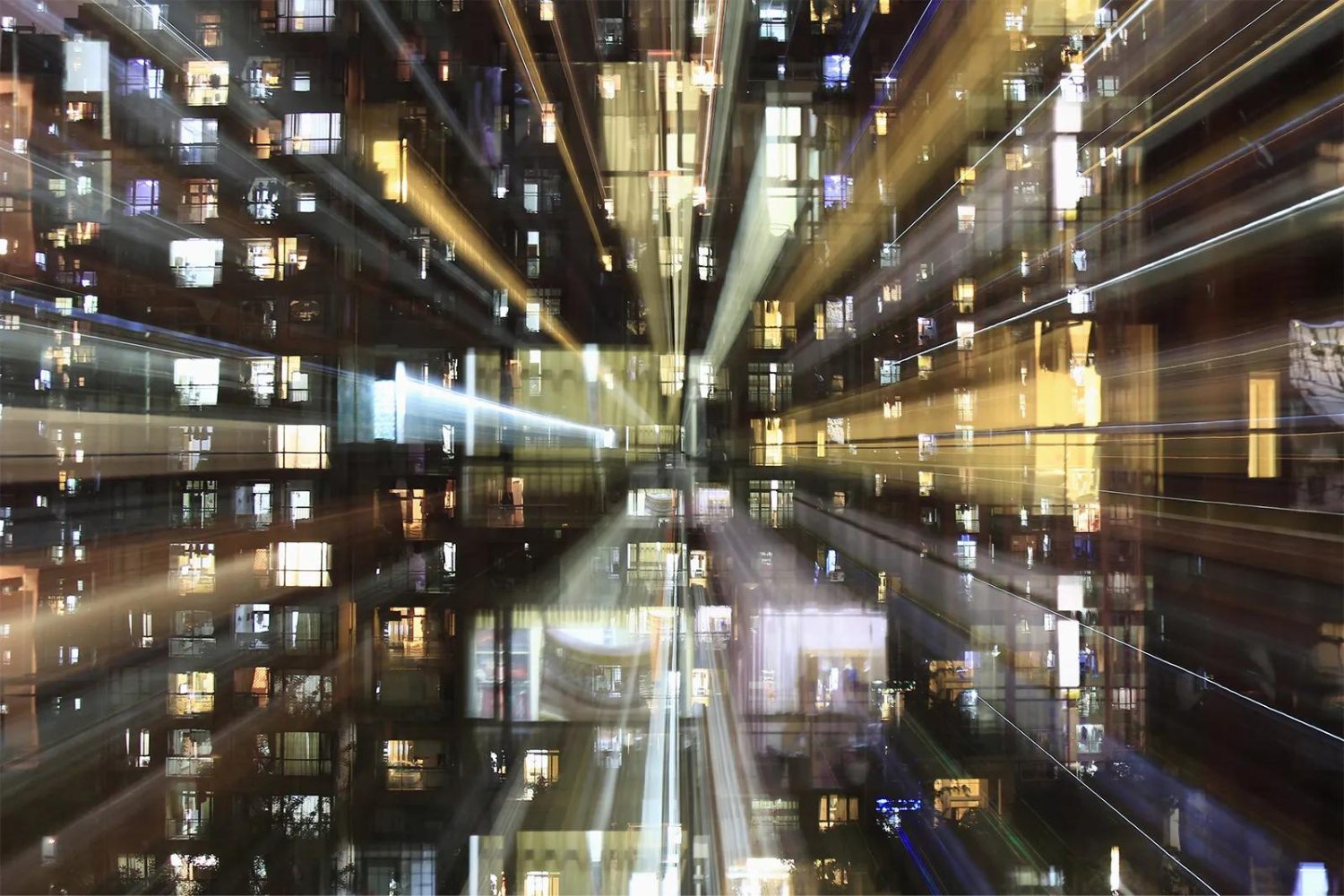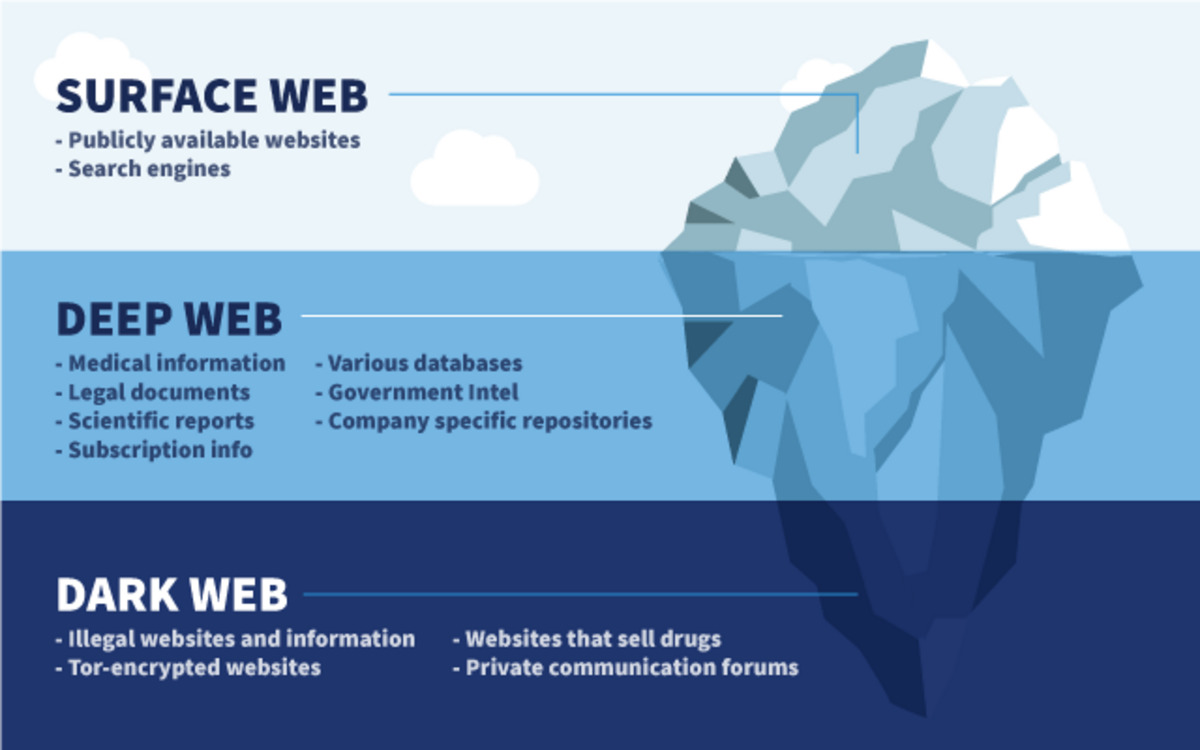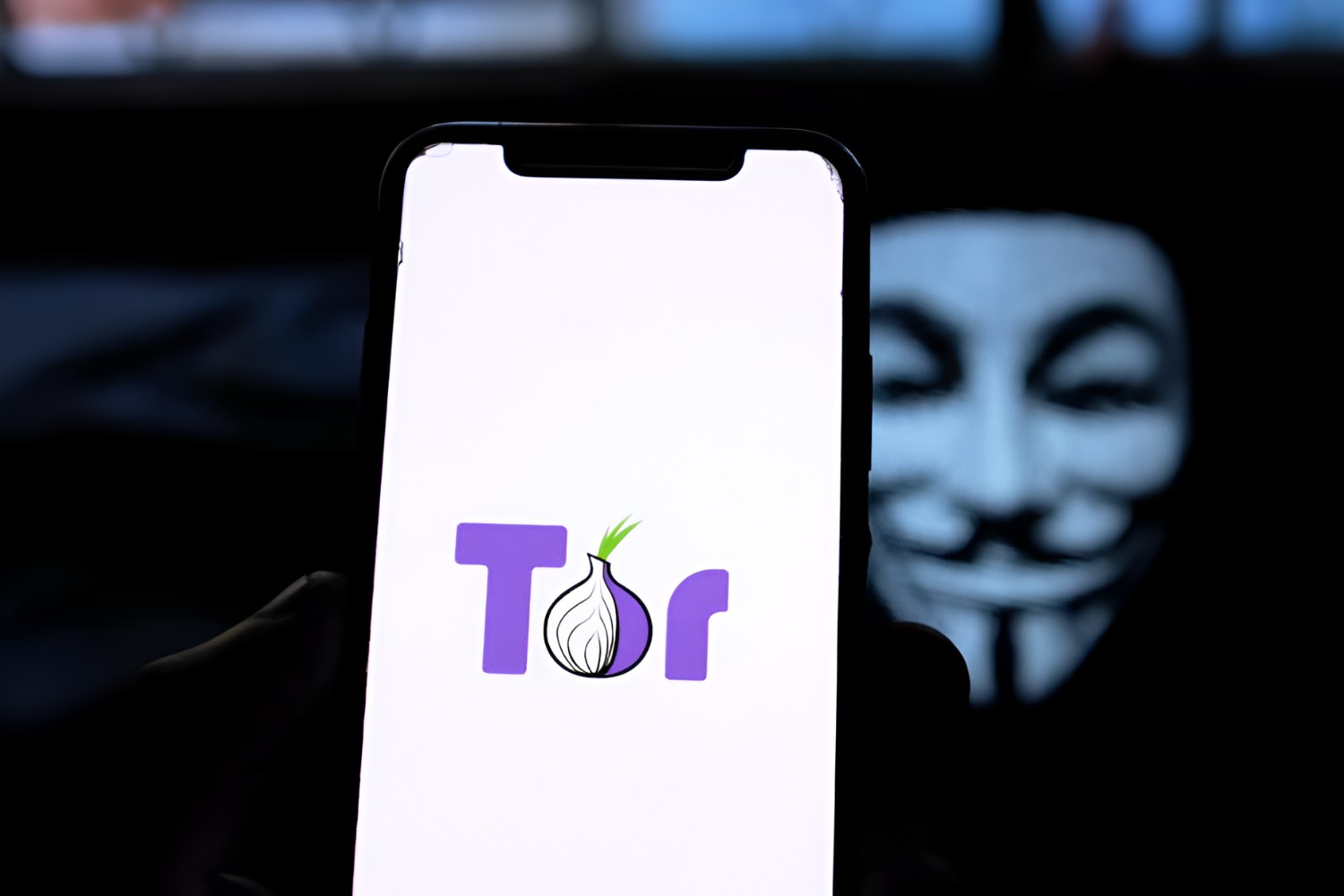Introduction
The Dark Web has become a popular topic of discussion in recent years, captivating the public’s curiosity and stirring up a sense of mystery. This hidden part of the internet is shrouded in secrecy, where illicit activities and anonymous communication thrive. But what exactly is the Dark Web, and how does it fit into the larger structure of the internet?
The Dark Web refers to a collection of websites that are not indexed by search engines and cannot be accessed through traditional browsers. It operates on a network known as Tor (The Onion Router), which provides users with anonymity by routing their internet traffic through various volunteer-operated servers.
Unlike the Surface Web, which encompasses the websites that we commonly browse and search for, the Dark Web remains hidden from the casual internet user. While estimates vary widely, it is believed that the Dark Web constitutes only a small fraction of the entire internet. But trying to determine the exact percentage of the Dark Web poses significant challenges.
In this article, we will explore the structure of the internet, define the Dark Web, and delve into the complexities of estimating its size. Additionally, we will examine the types of activities that take place on the Dark Web, both legal and illegal, shedding light on its shadowy reputation.
So, let’s journey into the depths of the internet and uncover the intriguing world of the Dark Web.
What is the Dark Web?
The Dark Web is a subsection of the internet that exists beyond the reach of traditional search engines. It is a collection of anonymous websites that cannot be accessed through regular browsers. These websites are hidden from view and are only accessible through special software, such as Tor, which anonymizes users’ internet connections.
What sets the Dark Web apart from the Surface Web is its emphasis on anonymity and privacy. While the Surface Web consists of websites that are easily accessible and indexed by search engines, the Dark Web operates on a different level of encryption and network configuration.
One of the primary technologies that powers the Dark Web is Tor. Tor, short for “The Onion Router,” is a network of volunteer-operated servers that routes internet traffic through multiple layers of encryption. This routing process obfuscates the user’s identity and location, making it virtually impossible to trace their online activities.
Within the Dark Web, users can engage in various activities that are often shielded from law enforcement and surveillance. For some, the Dark Web offers a platform for unrestricted free speech and activism, allowing individuals to express themselves without fear of censorship or retribution. Others use the Dark Web for legitimate purposes, such as secure communication, whistleblowing, or accessing information in regions with heavy internet restrictions.
However, it is important to note that the Dark Web also harbors illicit activities, including the buying and selling of drugs, weapons, stolen data, counterfeit goods, and hacking tools. Marketplaces, forums, and online communities dedicated to these activities exist within the hidden corners of the Dark Web.
Furthermore, the Dark Web also hosts illegal services, such as hiring hitmen, offering hacking services, and distributing explicit or illegal content. It is crucial to understand that while the Dark Web provides a platform for anonymous communication, it also facilitates criminal activities due to its anonymous and decentralized nature.
In the next section, we will explore how the internet is structured, which will help us understand the relationship between the Dark Web and the rest of the online world.
How is the Internet structured?
The internet, often referred to as the “World Wide Web,” is a vast network of interconnected computers and servers that spans the globe. It is a decentralized system where information flows through a complex web of connections. Understanding the structure of the internet is essential to grasp the role and positioning of the Dark Web within this network.
The internet is structured in layers, each serving a specific purpose and function. At the core of the internet architecture is the internet backbone, which consists of high-capacity fiber-optic cables and network equipment. These backbone networks interconnect major data centers and internet service providers (ISPs) worldwide, forming the backbone of the internet’s infrastructure.
Building on top of the internet backbone is the Surface Web, also known as the visible or indexed web. The Surface Web encompasses all the websites that can be easily accessed through search engines like Google, Bing, or Yahoo. These websites are indexed and organized, making them discoverable to anyone with an internet connection and a search query.
However, the Surface Web represents only a small fraction of the entire internet. Beneath the Surface Web lies the Deep Web, which includes all the unindexed webpages and databases that search engines cannot access. The Deep Web is vast and comprises content that is hidden behind paywalls, private networks, or password-protected areas, such as online banking, government databases, and academic resources.
Within the Deep Web lies the Dark Web, the hidden and anonymous part of the internet that cannot be accessed through regular browsers. The Dark Web is intentionally concealed and requires special software, such as Tor, to navigate its network of encrypted connections.
It is crucial to understand that the Dark Web is not inherently illegal or malicious. While it does provide a platform for illicit activities, it also serves legitimate purposes, such as protecting online privacy, enabling secure communication, and facilitating anonymity for activists or individuals in oppressive regimes.
By grasping the layered structure of the internet, we can appreciate the Dark Web’s unique place within this framework. In the next section, we will dive deeper into the nuances of the Dark Web and explore its different layers.
The Surface Web: What most people use
The Surface Web, also known as the indexed web or the visible web, is what most people are familiar with when they think of the internet. It refers to the websites and content that can be easily accessed and indexed by search engines. These websites are designed to be publicly available and are the primary means through which individuals and businesses share information, communicate, and conduct online transactions.
The Surface Web is where billions of webpages reside, covering a wide range of topics and interests. It includes news websites, blogs, e-commerce platforms, social media networks, forums, educational resources, government websites, and much more. It is the realm of Google search results, where people navigate the internet to find the information they need.
Search engines play a vital role in indexing and organizing the Surface Web, making it easily discoverable by users. They employ web crawlers or bots that scour the internet, following links and collecting information from webpages. This data is then indexed in search engine databases, allowing users to find relevant websites by entering search queries.
Compared to the Dark Web and the Deep Web, the Surface Web represents only a small fraction of the entire internet. However, it is the most accessible and commonly used part by the general public. Websites on the Surface Web are designed to be user-friendly, visually appealing, and optimized for search engine visibility.
Moreover, the Surface Web is governed by various legal and regulatory frameworks that aim to ensure privacy, security, and accessibility for users. Website owners must comply with laws relating to data protection, copyright infringement, online transactions, and other digital rights and responsibilities.
While the Surface Web allows individuals and businesses to establish an online presence, it also has its limitations. The information available on the Surface Web is subject to manipulation, misinformation, and censorship. It is important for users to critically evaluate the content they encounter and ensure its accuracy and reliability.
Although the Surface Web is what most people use and interact with on a daily basis, it is only the tip of the iceberg when it comes to the vastness of the internet. In the next section, we will venture into the hidden layers of the internet and explore the Deep Web.
The Deep Web: A hidden part of the Internet
Beneath the Surface Web lies the vast and mysterious realm known as the Deep Web. Often misunderstood and misrepresented, the Deep Web refers to the parts of the internet that are not indexed by search engines and cannot be accessed through traditional means.
The Deep Web encompasses a wide range of content that is hidden from view, including private databases, password-protected websites, academic portals, medical records, subscription sites, and more. It comprises any online content that is not easily discoverable through search engine queries.
Unlike the Dark Web, the Deep Web does not require special software or encryption to access. It is not inherently illicit or nefarious, but rather a hidden part of the internet that is intentionally kept private or restricted to a specific group of users. For example, online banking portals, email accounts, or corporate intranets are all part of the Deep Web. These areas require authentication or specific permissions to access.
One of the reasons the Deep Web exists is to protect sensitive information from public exposure. For instance, medical professionals access patient records in secure portals, researchers access proprietary data, and governments storing confidential information behind firewalls. These areas of the Deep Web prioritize privacy and security for individuals and organizations.
It is important to highlight that not all content on the Deep Web is legal or ethical. While there are legitimate uses for the Deep Web, there are also parts that harbor illegal activities, such as illicit trading, underground markets, and forums for illegal content sharing. However, it is crucial to recognize that the Deep Web is not defined solely by its illicit elements.
The size and scale of the Deep Web are difficult to measure accurately. It is estimated that the Deep Web is significantly larger than the Surface Web and the Dark Web combined. This is because it encompasses a multitude of hidden databases, private networks, and restricted content that is constantly evolving.
To navigate and explore the Deep Web, individuals may need specific access credentials, such as usernames, passwords, or invitation-only links. In some cases, individuals may require member-only access codes or specific software to enter closed online communities or forums.
Understanding the Deep Web is crucial to grasp the full scope of the internet. While the Surface Web is the visible tip of the iceberg, the Deep Web represents the hidden mass beneath the surface. In the next section, we will dive into the depths of the Dark Web and delve into its unique characteristics.
Understanding the Dark Web
The Dark Web, with its enigmatic reputation, remains a subject of intrigue and curiosity. To fully comprehend the Dark Web, we must explore its unique features and the underlying technologies that make it distinct from the rest of the internet.
One of the essential aspects of the Dark Web is its emphasis on anonymity and privacy. Users access the Dark Web through specialized software, most notably Tor (The Onion Router), which is widely used to navigate this hidden network. Tor functions by encrypting and routing internet traffic through a series of volunteer-operated servers, shielding the user’s identity and location.
The Dark Web is designed to provide a platform for secure and anonymous communications, resisting surveillance from governments and third-party entities. This makes it an attractive medium for whistleblowers, activists, journalists, and individuals seeking to protect their privacy. The focus on anonymity enables users to bypass restrictions imposed by surveillance states or oppressive regimes.
Within the Dark Web, websites have addresses ending in “.onion” instead of the typical “.com” or “.net.” These “.onion” websites are not indexed by search engines and cannot be accessed through regular browsers. Instead, users need the Tor browser or other similar software to access these sites.
It is important to note that while the Dark Web can host legal and legitimate content, it is also known for facilitating a wide range of illegal activities. Marketplaces within the Dark Web offer opportunities for the buying and selling of drugs, weapons, stolen data, counterfeit money, and other illicit goods. Additionally, hacking services, identity theft tools, and illegal pornography can be found in hidden corners of the Dark Web.
The Dark Web encompasses distinct layers, with each layer offering different levels of anonymity and accessibility. The first layer consists of publicly accessible websites, similar to those on the Surface Web. These sites may have privacy or content restrictions but still operate within a relatively open environment.
As we move deeper into the Dark Web, we encounter the second layer, known as the “darknet.” The darknet consists of websites that require specific authorization or credentials to access. These sites are typically associated with more illicit activities, fostering anonymous marketplaces and channels for illegal content distribution.
The deepest layer of the Dark Web is known as the “marianas web” or “phantom web,” a hypothetical concept representing the most secretive and encrypted part of the Dark Web. It is believed to be reserved for intelligence agencies, high-level hacking groups, and exclusive organizations involved in covert operations.
Understanding the layers and dynamics of the Dark Web provides insight into its complexity and the wide range of activities that take place within its hidden channels. This knowledge helps shed light on the challenges faced in estimating the size and percentage of the Dark Web, which we will explore in the next section.
Different layers of the Dark Web
The Dark Web is not a monolithic entity but rather comprises different layers, each with its own characteristics and levels of accessibility. Understanding these layers is essential to comprehend the complexity and diversity within the hidden realm of the Dark Web.
The first layer of the Dark Web consists of publicly accessible websites that are similar to those found on the Surface Web. These websites can be accessed using the Tor browser and have addresses ending in “.onion.” However, they have varying degrees of privacy and content restrictions. Some of these websites may require registration or invite-only access, while others may be openly accessible to anyone.
Beneath the first layer lies the second layer, often referred to as the “darknet.” The darknet encompasses websites that are not openly accessible and require specific credentials or authorization to enter. These sites operate within closed networks and are commonly associated with more illicit activities, such as illegal marketplaces, forums, and communities.
Within the darknet, specialized marketplaces serve as platforms for buying and selling various illegal goods and services. These marketplaces offer anonymity to buyers and sellers, often using digital currencies like Bitcoin to facilitate transactions. Drugs, firearms, stolen data, counterfeit documents, and hacking tools are among the illicit items commonly traded on these platforms.
Beyond the darknet, there are even more hidden layers of the Dark Web that are accessible only to a select few. These layers are often referred to as the “deep dark web” or “marianas web.” These terms are more speculative and hypothetical, representing the deepest and most secretive parts of the Dark Web.
The concept of the “marianas web” or “phantom web” is often associated with conspiracy theories and suggests the existence of highly advanced and encrypted networks accessible only to sophisticated organizations, intelligence agencies, or elite hackers. However, it is important to note that concrete evidence of these exclusive layers remains elusive, and their exact nature and accessibility are subject to speculation.
The varying layers of the Dark Web create a complex ecosystem that encompasses a wide range of activities, from legal and legitimate uses to illicit and criminal pursuits. It is important to approach the Dark Web with caution and awareness, as navigating its layers can expose individuals to illegal content, scams, cyber threats, and potential legal repercussions.
While the Dark Web is often associated with illegal activities, it is crucial to recognize that not all websites and users within its hidden depths are engaged in illicit behavior. The Dark Web presents opportunities for secure communication, protection of online privacy, and anonymous expression for individuals living under repressive regimes or facing censorship.
Exploring the different layers of the Dark Web allows us to grasp the complexity of this hidden realm and the challenges associated with understanding its true scope and size. In the next section, we will examine the difficulties encountered in estimating the percentage of the Dark Web within the broader internet landscape.
Estimating the size of the Dark Web
Determining the precise size and percentage of the Dark Web is a challenging task due to its inherent nature of anonymity and limited accessibility. The hidden nature of the Dark Web makes it difficult to gather accurate data, and various estimation methods can result in widely varying figures.
Traditional search engines like Google and Bing do not index the Dark Web, which means that the standard methods of web crawling and indexing cannot be applied. As a result, researchers and experts rely on alternative approaches to estimate the size of the Dark Web.
One common method used to estimate the size of the Dark Web is by monitoring the number of active Tor hidden services or “.onion” websites. These websites can be accessed through the Tor network and are specific to the Dark Web. However, this method does not account for hidden services that may not be publicly available or are not part of the Tor network.
Another approach involves analyzing the data provided by law enforcement agencies and cybersecurity firms. These organizations actively monitor and investigate Dark Web activities to combat illicit activities. Although this data can provide insights into the Dark Web’s size, it may be limited in scope and may not capture the entire range of hidden websites and services.
It is worth noting that the Dark Web is constantly evolving, with websites being created and shut down regularly. This dynamic nature further complicates the task of estimating its size. New websites emerge, while others become inactive or are taken down due to law enforcement efforts.
The precise size of the Dark Web is also influenced by individual definitions and interpretations of what constitutes the Dark Web. Different studies and reports may use varying criteria to define the boundaries of the Dark Web, leading to discrepancies in size estimations.
Due to these challenges, estimates of the Dark Web’s size vary widely. Studies have suggested that the Dark Web represents a small fraction of the overall internet, ranging from less than 0.01% to around 4% of the total content available. However, it is important to approach these estimates with caution, as the true size of the Dark Web remains elusive.
Regardless of the exact percentage, it is clear that the Dark Web represents a fraction of the internet, with the majority of online content residing on the Surface Web and the Deep Web. Understanding the limitations of estimating the size of the Dark Web allows us to approach discussions about its scale with a level of skepticism and critical thinking.
In the next section, we will explore the activities that take place on the Dark Web, both legal and illegal, shedding light on its reputation as a hub for illicit behavior.
Challenges in determining the percentage of the Dark Web
Estimating the percentage of the Dark Web within the broader internet landscape poses significant challenges, primarily due to its hidden and anonymous nature. The clandestine characteristics of the Dark Web present several obstacles in accurately determining its size and proportion.
One of the core challenges lies in the lack of a comprehensive index or centralized authority that monitors and records the content and activities on the Dark Web. Unlike the Surface Web, which can be crawled and indexed by search engines, the Dark Web operates within encrypted networks and requires specialized software to access. This makes it difficult to gather systematic and extensive data on the hidden websites and services that exist within.
Additionally, the ever-evolving and dynamic nature of the Dark Web presents hurdles in quantifying its size. Websites within the Dark Web can appear and disappear rapidly, making it challenging to capture an accurate snapshot of its content and activities at any given time. The fluidity of the Dark Web makes it a continuously shifting landscape that poses difficulties in estimating its percentage when its boundaries are constantly changing.
The lack of transparency also hinders the ability to determine the full extent of the Dark Web. Due to its intentional anonymity and encryption features, it is challenging for researchers and experts to gain comprehensive access to the hidden services and understand the true scale of its offerings. There are inherent limitations in accessing the Dark Web for data gathering and analysis purposes, which further complicates the estimation process.
Moreover, defining the scope and boundaries of the Dark Web itself is a subjective matter. Different studies and reports may employ varying criteria to define what falls within the Dark Web, leading to discrepancies in size estimations. Without a standardized definition, it becomes challenging to arrive at a universally agreed-upon percentage.
Lastly, data reliability is another significant challenge. The information available about the Dark Web often comes from law enforcement agencies, cybersecurity firms, or informal sources. This data may not always be comprehensive, consistent, or publicly accessible, making it difficult to validate and replicate findings across different studies.
Given these challenges, accurately determining the percentage of the Dark Web becomes an elusive goal. While various estimation methods exist, it is crucial to approach any percentage figure with caution and acknowledge the inherent limitations and uncertainties associated with them.
Despite these challenges, ongoing research, advancements in technology, and collaborative efforts may offer promising avenues for gaining a better understanding of the Dark Web’s size in the future. However, for now, the true percentage of the Dark Web within the entirety of the internet remains a subject of debate and speculation.
In the next section, we will delve into the activities that take place on the Dark Web, providing insights into both the legal and illegal aspects that contribute to its notoriety.
Legal and illegal activities on the Dark Web
The Dark Web harbors a complex mix of legal and illegal activities, contributing to its reputation as a hub for both illicit behavior and legitimate uses. It is important to recognize that while the Dark Web has gained notoriety for its association with illegal activities, it is not solely a haven for criminals. Understanding the duality of the Dark Web can help navigate through the misconceptions surrounding its nature.
Illegal activities are undoubtedly present within the Dark Web. Marketplaces within this hidden realm facilitate the buying and selling of illegal goods and services, such as narcotics, firearms, counterfeit money, stolen data, and hacking tools. These marketplaces offer anonymity, secure communication, and rely on cryptocurrencies to ensure transactions are conducted with relative anonymity.
Furthermore, the Dark Web has been linked to criminal activities like identity theft, credit card fraud, and hacking-for-hire services. It provides a platform for the exchange of hacking tools, tutorials, and information that can enable malicious cyber activities.
Additionally, explicit and illegal content, including child pornography, is sadly prevalent within certain corners of the Dark Web. Law enforcement agencies globally work diligently to identify and shut down such sites, employing a range of investigative techniques to protect the vulnerable and hold perpetrators accountable.
It is crucial to emphasize that the Dark Web is not exclusively dedicated to illicit activities. There are legal and legitimate uses as well. For instance, individuals living in countries with oppressive regimes or facing extensive censorship may turn to the Dark Web to bypass restrictions and access uncensored information. Whistleblowers and journalists seeking to protect their identity and securely communicate with sources often rely on the anonymity provided by the Dark Web.
Moreover, the Dark Web hosts forums and communities that foster discussions on topics like privacy, security, cryptography, and activism. These online spaces provide individuals with the opportunity to share knowledge, exchange ideas, and participate in discussions that may be restricted or censored elsewhere.
Furthermore, the Dark Web serves as a platform for individuals to exercise their right to freedom of expression, enabling the dissemination of alternative viewpoints or controversial content that could face censorship on the Surface Web.
While the Dark Web’s illicit activities are a cause for concern, it is vital to avoid generalizations that portray the entire Dark Web as solely criminal. It is a complex landscape with a wide range of actors and behaviors. Authorities worldwide continue to collaborate to identify and target illegal activities on the Dark Web, aiming to hold perpetrators accountable for their actions while acknowledging the legitimate uses that exist.
In the next section, we will reflect on the information discussed throughout the article and summarize the key points about the Dark Web.
Conclusion
The Dark Web is a fascinating and complex part of the internet that captures the imagination of many. It encapsulates a hidden realm where anonymity, privacy, and illicit activities coexist. By delving into the layers of the internet, we have explored the Dark Web’s place within the larger structure of the online world.
We began by defining the Dark Web as a hidden subsection of the internet that operates on an encrypted network, accessible primarily through the Tor browser. We discovered that the Dark Web is just one part of a layered internet architecture, with the Surface Web being the visible tip, the Deep Web comprising unindexed content, and the Dark Web existing as a hidden and encrypted portion.
Although estimating the size and percentage of the Dark Web remains challenging due to its dynamic and anonymous nature, we discussed different approaches used to quantify its scale. These estimations provide only a glimpse into the vastness of the Dark Web, which encompasses both legal and illegal activities.
We explored the legal and non-malicious applications of the Dark Web, such as protecting privacy, anonymous communication, and accessing restricted information. Simultaneously, we acknowledged the illicit activities that take place, including the sale of illegal goods, dissemination of illegal content, and cybercriminal endeavors.
In recognizing this duality, it is important to approach discussions about the Dark Web with nuance and avoid generalizations that paint the entire realm as exclusively criminal. The Dark Web is a complex ecosystem with multifaceted actors and motivations.
As the Dark Web continues to evolve and adapt, it is essential for law enforcement agencies, cybersecurity experts, and researchers to collaborate in combating the illegal activities that occur within its depths while ensuring that legitimate uses and personal freedoms are respected.
Increasing public awareness and understanding of the Dark Web can empower individuals to navigate the online world with caution and discernment. Recognizing the challenges and limitations in determining the true extent of the Dark Web allows for a more informed perspective when engaging in discussions about its impact and implications.
By peering into the Dark Web, we gain a glimpse of the hidden layers and activities that shape the internet we know. As technology progresses and our understanding deepens, further exploration and research will shed light on this enigmatic part of the online world.

























